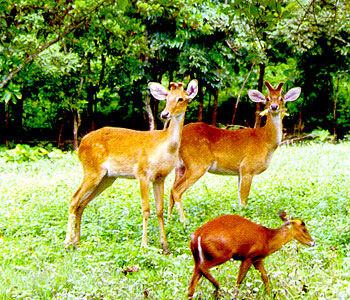 Keibul Lamjao National Park is located in the Bishnupur district of the state of Manipur in India at a distance of 40 kms from Imphal. It attracts a large number of tourists every year which has the unique floating parks .This is an unique tourist spot which has world`s strange floating parks that form a part of the Loktak Lake.. This national park is mainly characterized by many floating decomposed plant materials locally called phumdis which provides food for the endangered Manipur Eld`s Deer or Brow-antlered Deer or Sangai also called the Dancing Deer. The park was initially declared as a Sanctuary in 1966, which was later on changed into a National Park in 1977.
Keibul Lamjao National Park is located in the Bishnupur district of the state of Manipur in India at a distance of 40 kms from Imphal. It attracts a large number of tourists every year which has the unique floating parks .This is an unique tourist spot which has world`s strange floating parks that form a part of the Loktak Lake.. This national park is mainly characterized by many floating decomposed plant materials locally called phumdis which provides food for the endangered Manipur Eld`s Deer or Brow-antlered Deer or Sangai also called the Dancing Deer. The park was initially declared as a Sanctuary in 1966, which was later on changed into a National Park in 1977.
History of Keibul Lamjao National Park
Keibul Lamjao National Park was initially discovered in Manipur in 1839 and named as Cervus eldi eldi in 1844 in the honour of Lt. Percy Eld - a British officer. It was later on re-discovered as the Keibul Lamjao Park by the environmentalist and photographer E.P.Gee, who declared this reserve as a national park to protect and conserve the deer now called Eld`s Deer`s subspecies Brow-antlered Deer (Cervus eldi eldi) or Sangai in Manipur. It has also been referred in the folklore and culture of the Manipur state which maintains the pride of the state and is the national animal of the state. From a small herd of 14 deer in 1975, its population has increased up to 155 in 1995.
Geography of Keibul Lamjao National Park
The park has a swamp with floating mass of vegetation created by accrual of organic garbage and biomass with soil particles. This thickens into a solid form called phumdis, at the south-eastern side of the Loktak Lake, which has been declared a Ramsar site. It covers two third`s to three fourth`s of the total park area .The water way through the park provides access by boats plying through the Loktak Lake.The reserve area of the park extends up to 9,884.2 acres in March 1997 was reduced to 5,337.5 acres in April 1988, under pressure from the local villagers. The swamp encompasses three hills, namely, Pabot, Toya and Chingjao that provides shelter to the large mammals during the monsoon season. The distinctive nature of the park is that it is "too deep to be marsh, too shallow to be a lake."
Climate of Keibul Lamjao National Park
Temperatures vary from a maximum of 34.4 degreeC in summer with a minimum of 1.7degreeC in winter. Humidity was a recorded as high as 81 per cent in August with a minimum of 49 per cent in March.
Flora of Keibul Lamjao National Park
Keibul Lamjao National Park has a wide variety of flora and fauna. Mainly known for the dancind deers, this park is composed of moist semi-evergreen forests. The grass land structure of the park is divided into three zones. Aquatic flora recorded in the park consisted of Zizania latifolia (Wild Rice) (Ishing kambong), Saccharum munja (Khoimom), S. bengalensis, Eiranthus procerus (Singnang), Discorea bulbifera (Phumha), Cynodon dactylon (Tinthou), Alpinia galangal (pullei) and Eichhornia crossipes (Kabokang). Hedychium coronarium (Loklei), Nelumbo nucifera (Thambal), Phragmites Karka (Tou) and 100 other species are found here. It has some unique plants like phumdi ataoba (floating) and the phumdi aruppa (sinking); reeds, grasses, and other plants. The lake is largely covered with Phragmites karka, Erianthus ravennae (elephant grass), Saccharum munja, S. latifolium, Alpinia allughas and Saccharum procerum and other species.
Fauna of Keibul Lamjao National Park
Along with the Brow-antlered deer - the Cervus eldi eldi (Sangai) the park also has Hog deer, Wild boar, Large Indian Civets, common otter, fox, jungle cat, golden cat, Bay bamboo rat, musk shrew, common shrew, flying fox and Sambar .Amongst other vertebrates found in the National Park are fishes including Channa striatus, Channa punctatus, Cyprinus carpio, Wallago attu and Puntius sophore (Pool barb), Amphibians and Reptiles including Keel back Tortoise, Viper, Krait, Cobra, Water cobra, krait (banded) Bungarus fasciatus, Asian rat snake (Beauty rat snake), python, Russel`s viper (Daboia), checkered garter snake and Common Lizard (Viviparous Lizard). Python molurus, are commonly fund.
Avifauna of Keibul Lamjao National Park
It also has some prominent bird species which are both migratory and resident avifauna species. Some of them are East Himalayan pied Kingfisher, Black kite, lesser sky-lark, Northern Hill Myna, Burmese Pied Myna, North Indian black Drongos, Lesser eastern jungle crow, Yellow headed wagtail, Spotbill duck, Blue-winged teal, Ruddy Shell duck, Threatened Hooded crane, Burmese sarus, Crane, Indian white breasted water hen and Crimson-breasted pied wood pecker.
Thus with its notable floras and faunas this national park shares some of the most picturesque sights of Manipur which describes the environment of Manipur. To maintain its ecological balance and rare species of animals steps have been taken for its conservation.











